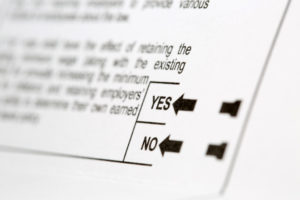 Here we go again!
Here we go again!
My last article examined Proposition 19, one of the measures on the November 2020 ballot that seeks to modify Proposition 13, California’s sui generis real property tax law. My current article takes a look at Proposition 15, which would, if passed by the voters, establish the “split roll” that has long been sought by local government advocates looking to restore the tax revenues eliminated by that groundbreaking initiative. This proposal would achieve that result by reassessing high-value commercial and industrial property at fair market value, leaving residential and some agricultural properties protected by Proposition 13’s limitations on reassessment.
I have what may be an unusual confession to make—I have been fascinated by Proposition 13 ever since California voters approved it in June, 1978. As a college student at that time, I had an intense interest in local public finance issues, rooted in observing heated public school funding disputes while growing up in San Antonio, Texas. Watching the debates over this proposed law on the news in my dorm room in South Bend, I found the rationales for and the intensity of the arguments made deeply intriguing. In particular, I was disturbed by the idea that older people could be forced from their homes due to high property taxes, as the measure’s backers claimed. While this problem was alien to my own experience, as the neighborhood where I grew up did not enjoy expensive property values or face high property taxes, and while I was (and am) also not averse to the concept of taxes per se, this result still seemed profoundly unfair to me.
This specific rationale in support of Proposition 13, however, is also at the core of the continued efforts to enact a “split roll.” Critics of the current system charge that, while it helps keep older Californians from being taxed out of their houses by maintaining their existing property tax assessments, it affords this benefit to all property owners, including large corporations with significant commercial/industrial land holdings, not just the retirees whose plight tugged at the heartstrings of voters. For detractors of California’s existing property tax regime, these particular beneficiaries of the protections of Proposition 13 are reaping the greatest reward under this law; a classic example given by opponents of the present law is Disneyland, owned by the Walt Disney Company, whose annual property tax bill would be almost $20 million more if the real estate comprising “happiest place on Earth” were taxed at fair market value.
While Howard Jarvis and Paul Gann may have played upon the public’s sympathies in their quest to enact their initiative, and while the predictions about its potential impact, both pro and con, may have been exaggerated, the bottom line today is that Proposition 13 has now been the law in California for over 40 years, and has become a basic aspect of tax planning for those Californians who own real estate. Thus, my difficulty with Proposition 15 is that it sets aside a major piece of legislation that California commercial property owners have relied upon for decades. When it comes to changing laws, tradition carries a great deal of weight; the longer they have been in effect, the more persuasive the rationale must be.
It may well be a good idea to examine the property taxes that large corporations pay, as proponents of Proposition 15 have argued. Making all high-value commercial and industrial real estate subject to fair market value reassessment is an overbroad means to this end, however, as the scope of this proposal would encompass commercial and industrial property owned by small businesses (including both individuals and families), as well as by large corporations. As with many potentially useful notions, the devil is in the details, but there might be a workaround under the current system that could address this situation.
The laws and regulations that implement California’s reassessment of property on change of ownership under Proposition 13 tend to focus on substance over form when it comes to transfers involving legal entities such as corporations. Thus, for example, property owned by cotenants who transfer title to a corporation in which their percentage ownership in that corporation is the same as their percentage ownership interest in the property will not be reassessed, but property owned by a corporation where title is not transferred but a change in control or ownership of the corporation occurs is subject to reassessment. In the case of small, closely-held corporations, changes in control occur more regularly given the fact that the ownership percentages of individuals who may transfer their ownership are higher and more likely to result in a change in control. In the case of large, publicly traded corporations like the Walt Disney Company, however, regular trading of shares of stock does not result in changes in control; while corporate takeovers potentially could trigger reassessment, as noted above, even reorganizations such as the Longs-CVS “reverse triangular merger” would not cause reassessment of their real property holdings.
Due to the impact the “split roll” would have on small businesses in California, Proposition 15 goes too far in dealing with the concerns raised by its advocates with respect to large corporations. Since those worries do have some merit, however, a better solution in my view would be to focus on the specific rules under Proposition 13 governing change of control of large corporations, to broaden that definition to include more situations in which a practical change in control of a large corporation occurs, such as when a new board of directors is appointed or corporate executives are replaced. In my view, such a complex modification would best be implemented by the legislature through statutes and regulations, rather than by initiative. As such, I would recommend a “no” vote on Proposition 15, and advocate instead that lawmakers precisely revise the change of control rules to address how large corporations are dealt with.
The text of Proposition 15 can be found here.



